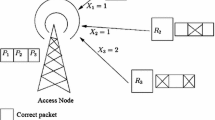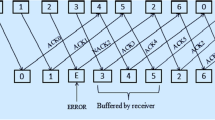Abstract
In this paper, we introduce a new hybrid ARQ technique for broadcasting or multicasting in erasure channel. The system is tested according to the objective criteria—quantity of information sent by the source, loses, and number of negative acknowledgments (NACKs) sent by the receiver nodes (end nodes). We compare our proposed method with automatic repeat request (ARQ), hybrid ARQ II (HARQ II), and also with a forward error correction (FEC) transmission technique based on Reed Solomon code (RS). The main focus of the presented HARQ is to reduce the quantity of redundant information sent by the source as well as the number of NACKs sent by the receivers, maintaining the condition that all the information is being recovered successfully by the receivers.
Similar content being viewed by others
Explore related subjects
Discover the latest articles, news and stories from top researchers in related subjects.References
Oyman, O. et al. (2010). Toward enhanced mobile video services over WiMAX and LTE. IEEE Communications Magazine, 48(8), 68–76.
Luby, M. et al. (2007). Reliable multimedia download delivery in cellular broadcast networks. IEEE Transactions on Broadcasting, 53(1), 235–246.
Yeung, R. W., & Cai, N. (2006). Network error correction, part I: basic concepts and upper bounds. Communications in Information and Systems, 6(1), 19–36.
Cai, N., & Yeung, R. W. (2006). Network error correction, part II: lower bounds concepts and upper bounds. Communications in Information and Systems, 6(1), 37–54.
Zhang, Z. (2008). Linear network error correction codes in packet networks. IEEE Transactions on Information Theory, 54(1), 209–218.
Burr, A. (2007). Wireless relay networks. In Proc. of ninth international symposium on communication theory and application (ISCTA’07), 16th–20th July, St Martin’s College, Ambleside, The Lake District, England (CD).
Van Wyk, J. L., Helberg, A., & Grobler, L. (2009). Comparing the implementation of network coding on different OSI layers. North West University, Potchefstroom Campus.
Badia, L., Casari, P., Levorato, M., & Zorzi, M. (2009). Analysis of an automatic repeat request scheme addressing long delay channels. In IEEE trans. international conference on advanced information networking and applications workshops.
Rossi, M., Badia, L., & Zorzi, M. (2003). Exact statistics of ARQ packet delivery delay over Markov channels with finite round-trip delay. In GLOBECOM’03.
Reed, I. S., & Solomon, G. (1960). Polynomial codes over certain finite fields. Journal of the Society for Industrial and Applied Mathematics, 8, 300–304.
Farkaš, P., & Baylis, J. (2000). Modified generalized weighted sum codes for error control. In Farrell, P., Darnell, M., & Honary, B. (Eds.) Communication theory and applications: Vol. 4. Coding communications and broadcasting (pp. 62–72). Baldock: Research Studies Press.
Farkaš, P. (2003). New family of error control codes and weight spectrum of [60, 49, 5]8 code obtained by computer. In The IEEE region 8 EUROCON 2003: computer as a tool, 22–24.9.2003, Ljubljana, Slovenia (pp. 212–215).
Rakús, M., Oboňa, J., & Farkaš, P. (2003). A new [56, 49, 5] high rate code for erasure correction constructed over GF (8). In The IEEE region 8 EUROCON 2003: computer as a tool, 22–24.9.2003, Ljubljana, Slovenia (pp. 208–211).
Farkaš, P., Zepernick, H.-J., & Wysocki, T. (1999). Performance of a hybrid ARQ scheme for partially reliable transport services. In Proceedings of VTC’99-Fall IEEE VTS 50th vehicular technology conference, Amsterdam, Netherlands (pp. 1299–1303).
Author information
Authors and Affiliations
Corresponding author
Rights and permissions
About this article
Cite this article
Yassine, A., Farkaš, P. One hybrid ARQ for broadcasting or multicasting in wireless erasure channel. Telecommun Syst 52, 1525–1532 (2013). https://doi.org/10.1007/s11235-011-9519-z
Published:
Issue Date:
DOI: https://doi.org/10.1007/s11235-011-9519-z




